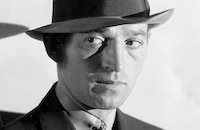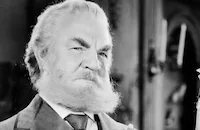The Big Brain
Cast & Crew
George Archainbaud
George E. Stone
Phillips Holmes
Fay Wray
Minna Gombell
Reginald Owen
Film Details
Technical Specs

Synopsis
After starting his career as a bootblack, diminutive Max Werner attends barber college and lands a job in a friend's barbershop, which at Max's urging, has had a gambling room added to it. Soon Max, the barber, becomes Max, the high-stakes gambler and promoter. Then through Margy, a manicurist with whom he is infatuated, Max meets "Slick" Ryan, a shady stocks and bonds dealer, and takes a job selling stocks. Although Max quickly proves himself invaluable to Slick, he quits the swindler when he catches him romancing Margy. One day, Max, who on his own has reaped financial success using questionable methods, meets Cynthia Glennon and Terry Van Sloan in a high-class speakeasy, but is snubbed by them. Although Cynthia is a wealthy heiress, Terry is penniless and so leaves for Europe to earn enough money to support her. At the same time, Max, whose shady dealings have attracted the attention of the district attorney, leaves for England on the same boat as Terry. While on board, Max allows himself to be swindled by a team of cardsharps, then proposes to the team's leader, Lord Darlington, that they join forces in England. Later in the voyage, Max saves Terry from Darlington's swindle and wins his friendship. Max offers Terry a job selling his stocks in England, and Terry, believing Max to be honest, accepts his offer. In London, Max, who has built up an enormous business, sends Darlington to Bucharest to purchase land for an oil scheme. After the phony Bucharest Oil Company is formed, Lord Latham, a London newspaperman, declares Max a fake. Max starts a lawsuit against Latham but then drops the case and prepares to leave the country. On the way to the dock, Max hears newsboys shouting that the Bucharest Oil Company has struck oil and immediately arranges for a phony English birth certificate to prevent Latham from deporting him. On Max's advice, Terry sends for Cynthia but, as soon as she arrives, he is shipped to Bucharest by Max. While Terry is away, Max romances and proposes to Cynthia but is soundly rebuffed by her. Angry, Max frames Terry during an investigation of the Bucharest scheme, then leaves for New Jersey with Darlington. To save Terry, Cynthia finds Max in New Jersey and pretends to be interested in him. After getting Max drunk with liquor and showing false affection, Cynthia convinces him to cross the state line into New York, where he is apprehended and extradicted by the authorities.

Director
George Archainbaud
Cast

George E. Stone

Phillips Holmes

Fay Wray

Minna Gombell

Reginald Owen
Lilian Bond
Reginald Mason

Sam Hardy

Lucien Littlefield

Douglass Dumbrille

Berton Churchill
Robert E. O'connor
Edgar Norton
Charles Mcnaughton

Lya Lys
Guy Usher
Claude King
Del Henderson
Montague Shaw
Crew
Sy Bartlett
Samuel Bischoff
Alf Burton
Al Cahen
Martin G. Cohn
Harry Davis
Ralph Delacy
Don Donaldson
Warren B. Duff
Bert Eason
Arthur Edeson
Roman Freulich
Charles Henley
Whitley Howett
Martin Jackson
Stanley Kolbert
Vernon Larson
Rose Loewinger
Robert Murphy
Gilbert Pollack
Eric Stacey
Hans Weeren

Film Details
Technical Specs

Articles
Fay Wray (1907-2004)
She was born Vina Fay Wray, in Cardston, Alberta, Canada on September 15, 1907. Her family relocated to Arizona when she was still a toddler so her father could find employment. When her parents divorced, her mother sent her to Hollywood when Fay's eldest sister died in the influenza epidemic of 1918. The reasoning was that Southern California offered a healthier climate for the young, frail Wray.
She attended Hollywood High School, where she took some classes in drama. After she graduated, she applied to the Hal Roach studio and was given a six-month contract where she appeared in two-reel Westerns (25 minutes in length), and played opposite Stan Laurel in his pre-Oliver Hardy days.
She landed her first big role, as Mitzi Schrammell, in Erich von Stroheim's beautifully mounted silent The Wedding March (1928). It made Wray a star. She then starred in some excellent films: The Four Feathers (1929), the early Gary Cooper Western The Texan (1930), and one of Ronald Coleman's first starring roles The Unholy Garden (1931), all of which were big hits of the day.
For whatever reason, Wray soon found herself in a string of thrillers that made her one of the great screamers in Hollywood history. The titles say it all: Doctor X, The Most Dangerous Game (both 1932), Mystery of the Wax Museum, The Vampire Bat (both 1933) and, of course her most famous role, that of Ann Darrow, who tempts cinema's most famous ape in the unforgettable King Kong (also 1933).
Wray did prove herself quite capable in genre outside of the horror game, the best of which were Shanghai Madness with Spencer Tracy; The Bowery (both 1933), a tough pre-Hays Code drama opposite George Raft; and the brutal Viva Villa (1934), with Wallace Beery about the famed Mexican bandit. Yet curiously, the quality of her scripts began to tank, and she eventually found herself acting in such mediocre fare as Come Out of the Pantry (1935), and They Met in a Taxi (1936).
With her roles becoming increasingly routine, the last of which was the forgettable comedy Not a Ladies Man (1942), she decided to trade acting for domesticity and married Robert Riskin, who won two Best Screenplay Oscars® for the Frank Capra comedies It Happened One Night (1934) and Mr. Deeds Goes to Town (1936). When Riskin died in 1955, Wray found herself working to keep busy and support her three children. She landed supporting parts for films like The Cobweb (1955), Hell on Frisco Bay (1956) and Tammy and the Bachelor (1957). She also found work in television on such popular programs as Perry Mason and Wagon Train before she retired from acting all together in the mid-'60s.
To her credit, Wray did remain reasonably active after her retirement. She published her autobiography, On The Other Hand in 1989 and was attending many film festivals that honored her contribution to film, most notably in January 2003, when, at 95 years of age, she accepted in person her "Legend in Film" Award at the Palm Beach International Film Festival. Wray is survived by a son, Robert Riskin Jr.; two daughters, Susan and Victoria; and two grandchildren.
by Michael T. Toole

Fay Wray (1907-2004)
Quotes
Trivia
This film is presumed lost. Please check your attic.
Notes
Although the copyright entry lists Admiral Productions, Inc. as the "author" of the film, no other information concerning that company's involvement in the production has been found. It is possible that Admiral was connected to KBS Productions, Inc., the company that is credited in all the reviews as the film's producer.














